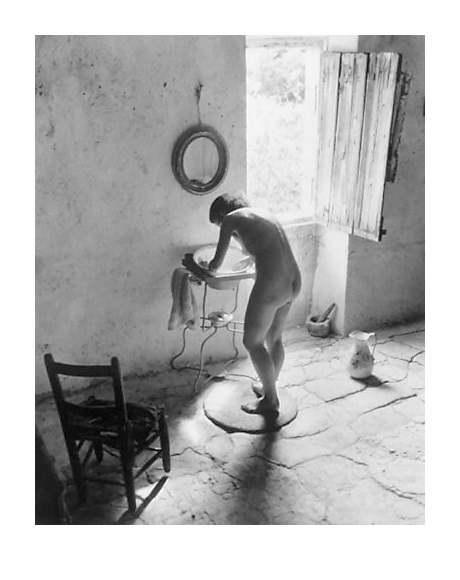
photography, writing, fine art... stuff ... other stuff ...
Willy Ronis, b. 1910, Paris. See Ronis online at Fetterman Gallery, or at Musee Nicéphone.
Le Nu Provençal, Gordes,1949

The image has been widely reproduced. If we limit reproduction to books published by Ronis
or under his direction, then sizes range from smaller than a postcard, to something that would fit
comfortably onto a wide-margined folio page.
The image is available for purchase from Ronis' authorised dealers as a traditional print with an
image size of 10 by 13 inches. This is relatively small, and the book reproductions are
smaller; this gives it, before we even consider the
content, a relatively intimate quality.
The image shows a young woman washing herself. She is standing in a room which is simply
furnished, has a tiled floor, wooden shutters, and a single chair which seems like a country-made
kitchen chair. She is standing in front of a simple iron washstand which carries a shallow bowl of
enamel or pottery. The walls of the room are plain and seem to be simply whitewashed plasterwork.
Through the open window we can see trees. The context, therefore, is rural, rustic, and might
even be considered, were it not for the relatively spacious room, to indicate poverty. Simplicity,
however, is perhaps a better word. In fact, were it not a photograph, and therefore inevitably later
than around 1840, the scene could just as well date from any time in the last 500 years or more.
Ronis describes the photograph as resulting from a chance encounter. The location is a
holiday home in Gordes which he and his wife had bought a couple of years earlier, and which they were
still in the process of renovating. As Ronis puts it, that particularly hot summer he was working
in the attic when ...
Pour chercher en bas un outil qui me manque, j'emprunte l'escalier de pierre qui passe
par notre chambre. Marie-Anne, qui émerge de sa sieste, se rafraîchit avec l'eau de la
cuvette, car l'eau courante, c'est au lavoir qu'elle se trouve. Je lui dis: reste comme
tu es, et, prenant l'appareil sur un bahut, je remonte quelques marches et déclenche trois
fois; puis j'oublie, car il y eut beaucoup d'autres photos durant ces vacances tout juste
commencées. Ce fut une bonne surprise, un fois rentré à Paris, lorsque je tirais les contacts ...
Ronis, W. Sur le fil du hasard, 1991, Paris, Contrejour, p. 17. First published 1980.
Or, in a more recent account, "I grabbed my camera and took four shots in under two minutes ..."
Ronis, W. Willy Ronis, 2002, London, Phaidon, no page numbering.
Although Ronis' published accounts of the incident vary, they all convey the notion
of an unexpected opportunity grabbed with a minimum of deliberation. No adjustment of
props, no use of lights. Two minutes is actually ample time to make a number of meter readings
and take four shots on the twin lens reflex cameras which Ronis used at the time, and the
contact sheet shows four images taken from almost identical positions, with no evident difference
of exposure; only Marie-Anne's position varies from shot to shot. The contacts, of course, are
all square in format, since Ronis used a 6cm by 6cm camera. Given the wide reproduction of the
image, tonality varies significantly in one version compared with another, but the crop is
always the same and I am not aware that it has ever been suggested that anyone but Ronis is
responsible for cropping the frame. The image has a portrait format,
equivalent to roughly 6 by 8 ... a significant elongation in comparison with the
original format.